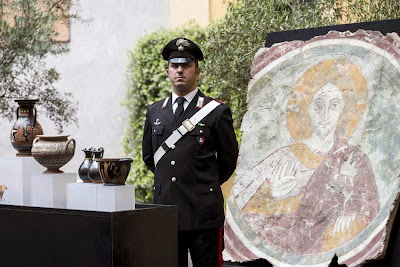 |
| Source: MiBACT |
It is clear that in spite of the 1970 UNESCO Convention auction houses, galleries and dealers continued to handle recently surfaced material from Italy, and that public museums (including university collections) and private collectors continued to acquire this material without asking serious questions about how the material arrived on the market.
Christopher Chippindale and I explored some of the themes in 2000 [see JSTOR] without access to the photographic archives. We were able to identify pieces without a collecting history that could be traced back to the period before 1970 that were subsequently returned to Italy.
Peter Watson's investigations into a major auction-house in London identified the way that objects were consigned to the market, and these sales have been represented by a number of objects that have been returned.
So why are dealers and museum directors calling for these photographic archives to be made public? First, they do not wish the lack of due diligence in the preparations for sales and acquisitions to be made public. Second, there is concern that there could be reputational damage if objects are identified in collections are sales.
So what can the market do? There needs to be an improvement in the due diligence process, and objects need to be provided with properly authenticated and documented collecting histories. Is that too much to ask?




1 comment:
hi david ,maybe they are calling for the archives to be published so that they can do their due diligence to a higher standard.we all agree that the ALR is not fit for purpose when it comes to looted pieces because they simply dont come up on the radar,the auction houses are in the same predicament.you use phrases such as "recently looted" or "recently surfaced" but some of these pieces have been published,sold and resold and have been in circulation for 25/35 or even 45 years,to keep calling them recently surfaced is stretching it a bit dont you think.
kyri.
Post a Comment